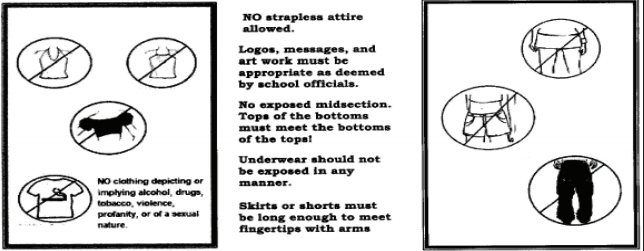Not “A” Distraction?
October 11, 2016
The clothing restrictions defined by the 2016-2017 BFA student handbook are designed to limit the sexualization of students.
However, it does the contrary in its process of execution that is unfairly enforced on the student body’s female population.
BFA Director of Guidance Preston Randall however, claims this is not true. “It sets a consistent standard for boys and girls,” Randall said.
However, on page 31 of BFA’s student handbook, seven images are displayed informing the reader of what is and is not acceptable. Five of them portray a feminine body, dressed in garments that expose the shoulders, midriff or thighs.
One image applies to a male body, disallowing baggy jeans.
A five to one ratio is not equality. Unfair rules cannot be enforced fairly.
The handbook goes on to prohibit clothes that are “sexually suggestive or provocative.” But who gets to deem a person too sexually explicit?
Is it ethical for an adult to ask a child to cover up because an exposure of a bra strap, midriff or collar bone sends to them a sexual message?
When asked how a person’s attire is deemed too sexual, “It’s a judgement call,” Randall said. “The intent has to do with not making sex objects out of our students,” he said, justifying the enforcement.
However, it does the contrary. The active dress code at BFA brands girls as being sexual symbols, temptations or distractions before they are even adults.
The reason the dress code exists is to “minimize distractions,” Randall said.
Clearly, not only for students.
“As a man that works in a school surrounded by teenage girls, I feel a certain vulnerability and I can be made uncomfortable by the way students dress,” Randall said.
The dress code defined in the student handbook almost gives the BFA staff members omnipotence.
The words, printed in bold on page 31 of the student handbook declares “There are clothing and accessories not acceptable for school. This includes, but is not limited to. . .,” This statement allows staff to deem anything a student wears unacceptable.
For example, on Aug. 31, the first day of school, Marlena Valenta (‘17) was “dress coded” by Assistant Principal Heather Fitzgibbons. Valenta quotes Fitzgibbons as saying “Honey, it’s clear you aren’t wearing a bra.”
Well within her right not to wear a bra, Valenta also was not out of dress code. The rules prohibit the exposure of underwear, but not the neglect of it. However, because of Fitzgibbon’s handbook-given right to enforce her personal taste on her students, Valenta was given two options. One to wear a winter coat on a hot day, or to leave school.
Sending a girl away from a classroom or placing her in circumstances where it is impossible to focus, like wearing a winter coat in summer, sends a message that hiding her body is more important than her education.
When informed of this infraction, Randall replied, “Well, was there something about that that was. . .discomforting?”
Randall was asked if he agreed that the handbook gave adults complete power over a person’s attire. “I suppose, yes,” Randall said.
The handbook at BFA supports an environment where a girl’s eligibility to be in a classroom depends on the way she chooses to present her body and the reactions of her male classmates and teachers, objectifying her.


Paula Johnson • Oct 25, 2016 at 3:05 pm
This article demonstrates a skewed view of teacher power as well as of gender inequality. I was uncomfortable with the use of administrator and student name in this article.